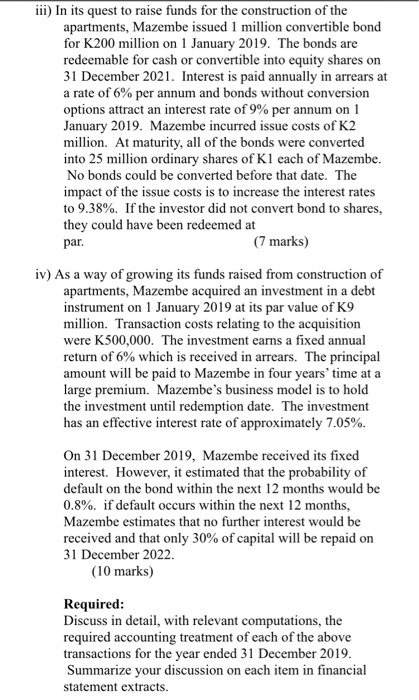You are the Chief Finance officer for Mazembe Limited, A company engaged in construction of apartments for third parties. Mazembe has 200 employees in total and the following transactions have arisen that require you advise on how they should be reported. i) Mazembe operates a pension plan for employees where the company does not guarantee return on the contributions paid into the fund. Instead, the company's obligation (legal or constructive) is limited to the amount contributed to the fund. On 31 December 2019, the company had fair value of plan assets amounting to K35 million, contributions paid by Mazembe into the fund amounting to K16 million and contributions paid by employees into the fund of K16 million. The interest rates on high quality bonds for Mazembe's pension plan are: 7% on 1 January 2019 and 10% on 31 December 2019. (3 marks) ii) Mazembe has two receivables at 31 December 2019 that it has factored to a bank in return for immediate cash proceeds. Both receivables are due from long standing customers who are expected to pay in full and on time. Mazembe had agreed a three-month credit period with both customers. The first receivable is for K400 million. In return for assigning the receivable, Mazembe has received K360 million from the factor. Under the terms of the factoring arrangement, Mazembe will not have to repay this money, even if the customer does not settle the debt. The second receivable is for K200 million. In return for assigning the receivable, Mazembe has received K 140 million from the factor. The terms of this factoring arrangement state that Mazembe will receive a further K10 million if the customer settles the account on time. If the customer does not settle the account in accordance with the agreed terms then the receivable will be reassigned back to Mazembe who will then be obliged to refund the factor with the original K 140 million. (5 marks) iii) In its quest to raise funds for the construction of the apartments, Mazembe issued 1 million convertible bond for K200 million on 1 January 2019. The bonds are redeemable for cash or convertible into equity shares on 31 December 2021. Interest is paid annually in arrears at a rate of 6% per annum and bonds without conversion options attract an interest rate of 9% per annum on 1 January 2019. Mazembe incurred issue costs of K2 million. At maturity, all of the bonds were converted into 25 million ordinary shares of Kl each of Mazembe. No bonds could be converted before that date. The impact of the issue costs is to increase the interest rates to 9.38%. If the investor did not convert bond to shares, they could have been redeemed at par. (7 marks) iv) As a way of growing its funds raised from construction of apartments, Mazembe acquired an investment in a debt instrument on 1 January 2019 at its par value of K9 million. Transaction costs relating to the acquisition were K500,000. The investment earns a fixed annual return of 6% which is received in arrears. The principal amount will be paid to Mazembe in four years' time at a large premium. Mazembe's business model is to hold the investment until redemption date. The investment has an effective interest rate of approximately 7.05%. On 31 December 2019, Mazembe received its fixed interest. However, it estimated that the probability of default on the bond within the next 12 months would be 0.8%. if default occurs within the next 12 months, Mazembe estimates that no further interest would be received and that only 30% of capital will be repaid on 31 December 2022. (10 marks) Required: Discuss in detail, with relevant computations, the required accounting treatment of each of the above transactions for the year ended 31 December 2019. Summarize your discussion on each item in financial statement extracts








